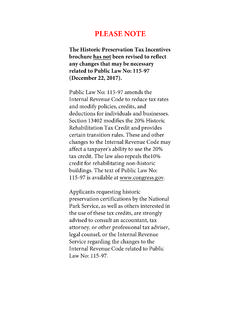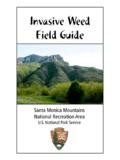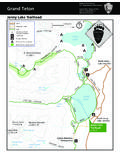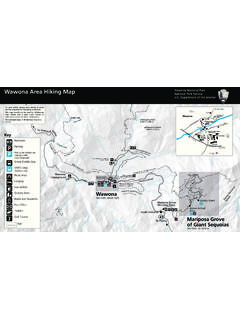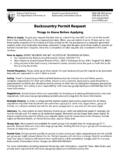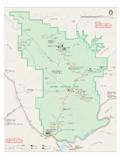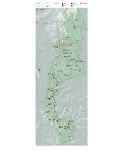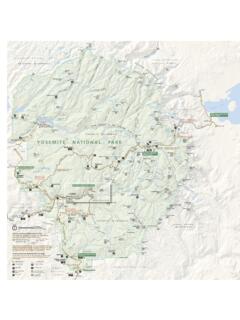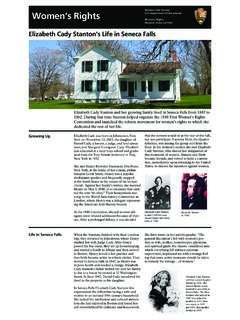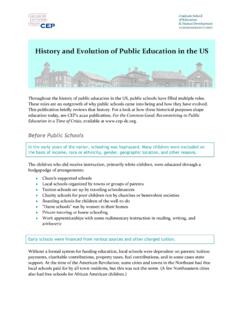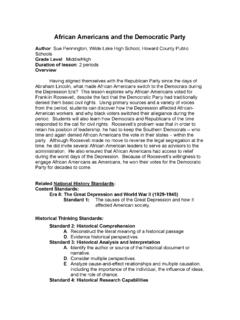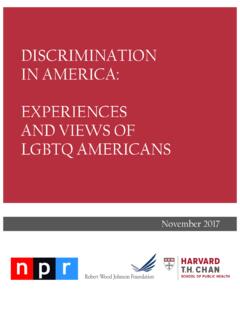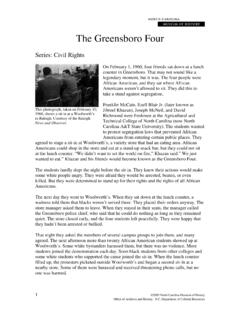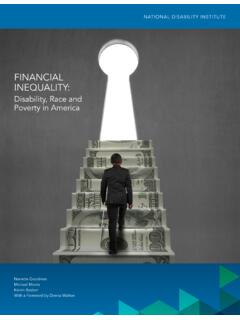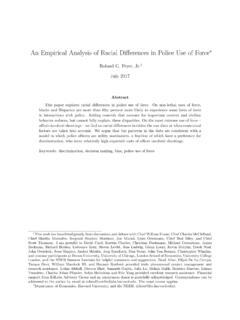Transcription of Civil Rights in America: Racial Voting Rights
1 National Park Department of the InteriorNational Historic Landmarks ProgramCivil Rights in America: Racial Voting RightsA National Historic Landmarks Theme Study Cover photograph: NAACP photograph showing people waiting to register to vote, 1948. Library of Congress, Prints & Photographs Division, Visual Materials from the NAACP Records [reproduction number: LC-USZ62-122260] Civil Rights IN AMERICA: Racial Voting Rights A National Historic Landmarks Theme Study Prepared by: Susan Cianci Salvatore, Project Manager & Historian, National Conference of State Historic Preservation Officers Consultant Essays prepared by the Organization of american Historians: Neil Foley, Historian Peter Iverson, Historian Steven F.
2 Lawson, Historian Produced by: National Historic Landmarks Program Cultural Resources National Park Service Department of the Interior Washington, 2007, Revised 2009 CONTENTS INTRODUCTION .. 1 HISTORIC CONTEXTS african american Voting Rights , 1865-1965 Part One, 1865-1900 .. 3 Part Two, 1900-1941 .. 14 Part Three, 1941-1954 .. 20 Part Four, 1954-1965 .. 30 american Indian Voting Rights , 1884-1965 .. 73 Hispanic and Asian american Voting Rights , 1848-1975 .. 102 NATIONAL HISTORIC LANDMARKS REGISTRATION GUIDELINES .. 111 METHODOLOGY .. 119 SURVEY RESULTS Properties Recognized as Nationally Significant .. 121 National Historic Landmarks Study List .. 123 Properties Removed from Further Study .. 125 Table 1. Properties Recognized as Nationally Significant.
3 129 Table 2. National Historic Landmarks Study List .. 130 Table 3. Properties Removed from Further Study .. 131 BIBLIOGRAPHY african american .. 132 american Indian .. 138 Hispanic .. 142 Asian american .. 144 General .. 144 APPENDICES Appendix A. Selma to Montgomery March: Chronology of Events .. 146 Appendix B. Chronology of the Mississippi Voting Campaign, 1961-1964 .. 149 Appendix C. Chronology of african american Voting Rights -Related Cases .. 152 Introduction 1 INTRODUCTION In 1999 the Congress directed the National Park Service to conduct a multi-state study of Civil right sites to determine the national significance of the sites and the appropriateness of including them in the National Park System. To determine how best to proceed, the National Park Service partnered with the Organization of american Historians to develop an overview of Civil Rights history entitled, Civil Rights in America: A Framework for Identifying Significant Sites (2002, rev.)
4 2008). The framework concluded that while a number of Civil right sites had been designated as National Historic Landmarks, other sites needed to be identified and evaluated. Taking this into account, the framework recommended that a National Historic Landmarks theme study be prepared to identify sites that may be nationally significant, and that the study be based on provisions of the 1960s Civil Rights acts. These include the Civil Rights Act of 1964 (covering Voting Rights , equal employment, public accommodations, and school desegregation enforcement), the Voting Rights Act of 1965, and the Fair Housing Act of 1968. This specific portion of the study focuses on the Voting Rights Act of 1965. Inclusion in the National Park System first requires that properties meet the National Historic Landmark criteria, and then meet additional tests of suitability and feasibility.
5 To establish guidance on meeting landmark criteria, this study provides a historic context within which properties may be evaluated for their significance in Civil Rights and creates registration guidelines for National Historic Landmark consideration. Completion of this study will also assist in the identification of sites for National Historic Landmark evaluation. Voting Rights Overview The Voting Rights Act of 1965 is generally considered the most successful piece of Civil Rights legislation ever adopted by the United States Congress. * Congress adopted this act in response to the ongoing obstruction african Americans faced in exercising their right to vote. As a result, african Americans were overwhelmingly disenfranchised in many Southern states.
6 The act s adoption followed nearly a century of systematic resistance by certain states to the Fifteenth Amendment guarantee of the right to vote regardless of race or color. While the Voting Rights Act was adopted in response to the african american struggle, other Racial groups also fought for enfranchisement. Hispanics, Asian Americans, and american Indians faced the same methods states used to exempt african american voters from the ballot box. Therefore, this study also describes voter discrimination issues faced by Hispanics, Asian Americans, and american Indians. Study Format To establish guidance on meeting landmark criteria, this study provides a historic context within which properties may be evaluated for their significance in Civil Rights and establishes registration guidelines for National Historic Landmark consideration.
7 The historic context contains separate essays on african american , american Indian, and the Hispanic and Asian american Voting Rights experience. All three stories begin at a different time period. The african american essay begins in 1865 with the abolition of slavery and the quest for the ballot. The american Indian essay begins in 1884 when the Supreme Court determined that * Quote from Introduction to Federal Voting Rights Laws, at , United States Department of Justice, Civil Rights Division, accessed on August 25, 2003. Introduction 2 Indians were not american citizens under the Fourteenth Amendment with the right to vote. The Hispanic essay begins in 1848 when the Treaty of Guadalupe Hidalgo granted citizenship to those who did not wish to retain their Mexican citizenship, and the Asian essay begins in 1878 when a federal court upheld the bar against naturalizing Chinese immigrants.
8 The african american and american Indian essays end in 1965 when Congress passed the Voting Rights Act and the emphasis in Voting Rights changed from an individual right to one of fair representation. The Hispanic and Asian american essays end in 1975 when Congress extended protection of the Voting Rights Act to language minorities. Registration guidelines then outline how properties may qualify for National Historic Landmark designation under this theme study. Subsequently, the methodology section describes how the survey proceeded. Properties identified during the course of the study are divided into three categories: 1) Properties Recognized as Nationally Significant, 2) National Historic Landmarks Study List, and 3) Properties Removed from Further Study.
9 Three appendices conclude the study. Appendix A provides a chronology of the Selma to Montgomery march. Appendix B provides a chronology of the Mississippi Summer Voting drive. Lastly, Appendix C lists african american Voting Rights -related cases. african american Part One, 1865-1900 3 african american Voting Rights , 1865-1965 An illustration in Harper s Weekly entitled, The first vote, 1867. Library of Congress, Prints & Photographs Division [reproduction number: LC-USZ62-97946] african american Part One, 1865-1900 4 PART ONE: 1865-19001 The right to vote has held a central place in the black freedom struggle. With abolition of slavery, african Americans sought the ballot as a means to claim their first-class citizenship.
10 When emancipated blacks pursued equality, they demanded the franchise on the same basis as that exercised by whites. Indeed, when Abraham Lincoln delivered his historic Gettysburg Address in 1863, universal white manhood suffrage existed in the North and the South. Democratic reforms over the previous half-century had whittled down property qualifications that excluded working class and poor white Americans from Voting . Once slaves obtained freedom with passage of the Thirteenth Amendment, they intended to participate actively in the political process and help advance their interests. Before emancipation, blacks residing in five New England states could vote. Maine, Massachusetts, New Hampshire, Rhode Island, and Vermont, which contained only 6 percent of the northern black population, had extended the right to vote to blacks.
